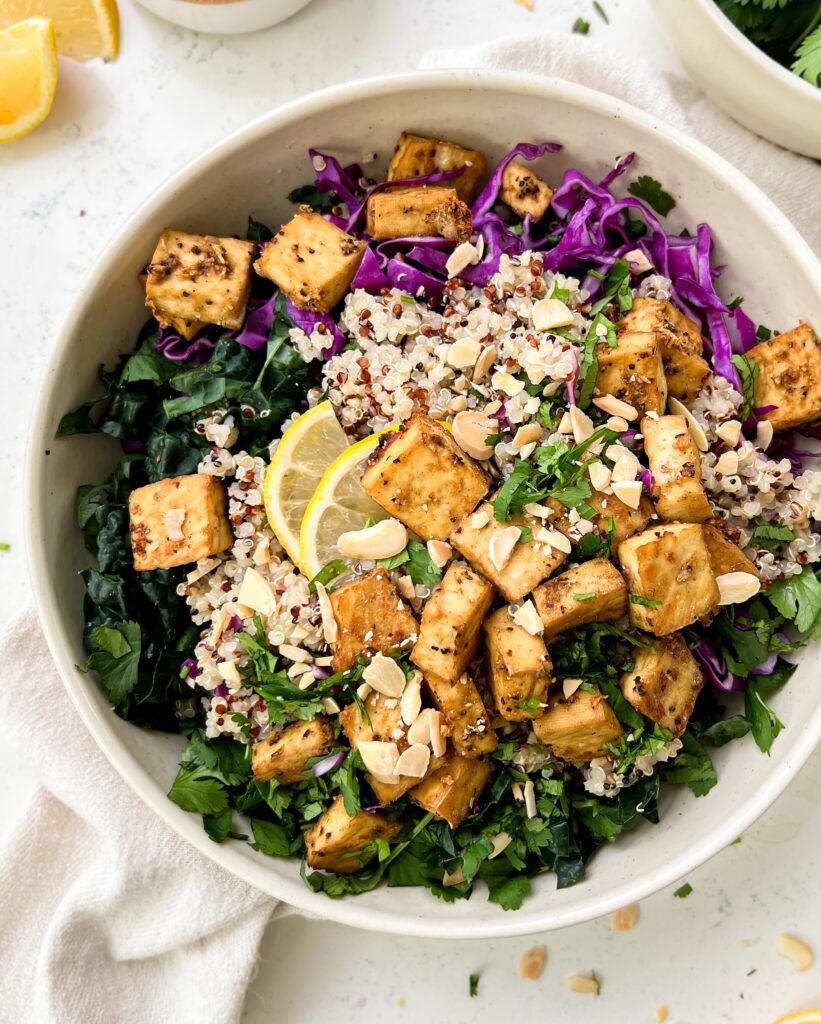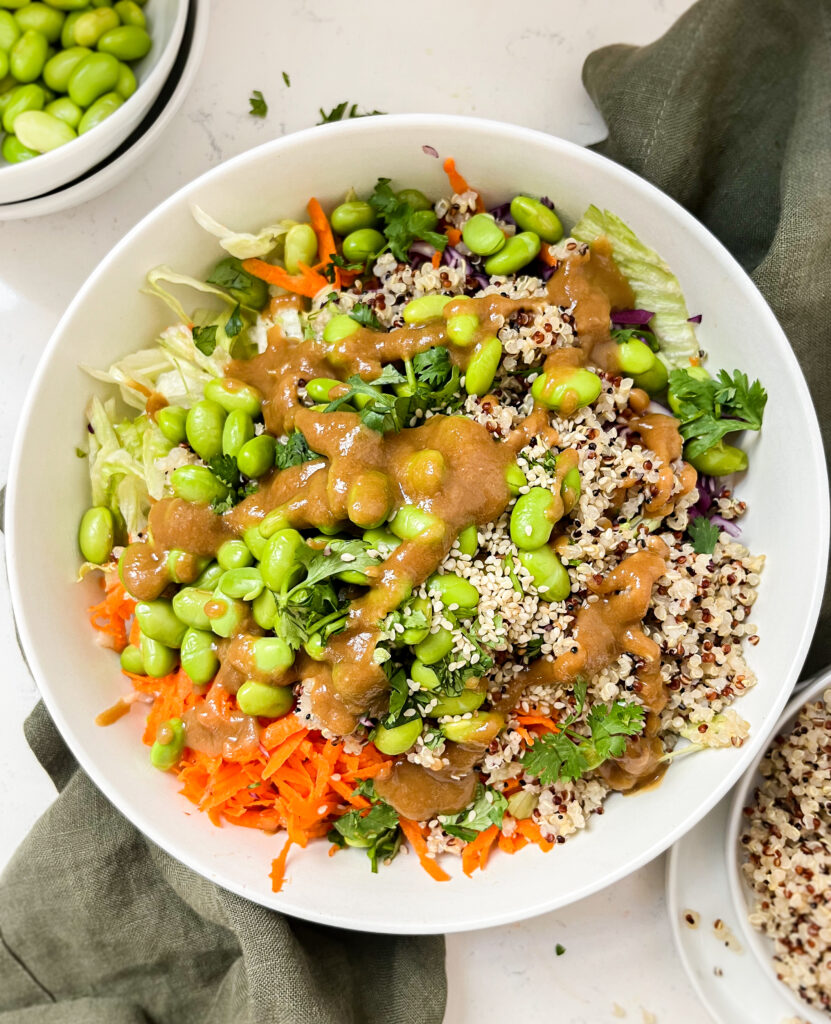Your Guide to Plant-Based Protein
I believe it’s a pretty common misconception that meeting protein needs on a plant-based diet is super hard and challenging.
Additionally, I know we’ve all heard the “but where do you get your protein” phrase that is all too familiar for those of us following a plant-based diet.
However, it couldn’t be simpler to get your protein from plants, especially if you’re eating a varied diet.
Once you know the principles behind how protein from plants functions, you’ll soon realize that it’s just as easy to get protein from plants as it is from meat. It just requires a tad more planning on your end haha.

Navigation Menu
Click on each link to easily navigate this blog post.
- What you need to know about protein
- What are amino acids??
- How much protein should you be eating
- Plant-based protein sources
- Complementary protein sources
What You Need to Know About Protein
Ok, before I get into plant-protein sources, I wanted to give some background on protein.
Protein is one of the three macronutrients (carbs, fats, and protein) and as one of the primary nutrients, it functions in several essential roles.
- Proteins like collagen and keratin (yeah, those powders everyone is always taking) are essential building blocks for muscle tissue, skin, etc.
- Protein is also essential to us as it acts as a form of transportation. Case in point, hemoglobin (a protein) that carries oxygen from the lungs to other tissues in your body
- Additionally, protein help with chemical reactions in the body (such as metabolic processes)
The Building Blocks of Protein
I’m sure you’ve heard of amino acids, aka the building blocks that make up protein.
There are a total of twenty amino acids, eleven of which are non-essential. Non-essential amino acids just means that our body can make them on our own.
So the main (read essential) amino acids we need to ensure we’re getting from food are histidine, isoleucine, leucine, lysine, methionine, phenylalanine, threonine, tryptophan and valine.
Ok, you’re probably wondering why I listed out all eleven, but I’ll reference back to these amino acids later in this article when we get into plant-protein sources.
But How Much Protein Should You Be Eating?
Another common misconception about protein (mostly driven by crazy gym culture) is that we need to be eating tons of protein.
This could not be further from the truth. Most of the population (with high-performing elite athletes, small children and pregnant women being the exception) really only need a moderate amount of protein per day. This goes even for people who are active and exercise a lot.
As a rule, protein requirements for the average adult is around 0.8g/kg – 1.0g/kg of body weight. For example, for someone who weighs around 120 lbs would only need max around 54g of protein per day.
Obviously, there are exceptions to this rule (such as pregnancy, diabetes, etc.), just note that for personalized nutritional requirements you should always speak to a registered dietitian.

Plant-Based Protein Sources
Ok, we’re finally to the good part, plant-protein sources. I’m sharing some of my go-to plant-protein sources that I have throughout the week / day that I heavily rely on.
Legumes
- Tempeh – 18g per 3 oz serving
- Tofu – 16g per 6 oz serving
- Edamame – 9g per 1 cup
- Beans – ranging between 8-10g per ½ cup
- Lentils – ranging between 18-20g per 1 cup
Grains
- Rolled oats and quick oats – 7g per ½ cup
- Quinoa – 4g per ½ cup
Nuts and Seeds
- Hemp seeds – 12g per 3 tbsp
- Pumpkin seeds – 7g per 2 tbsp
- Sunflower seeds (or sunflower butter) – 8g per 2 tbsp
- Almonds – 7g per ¼ cup serving
- Chia seeds – 8g per ¼ cup serving
- Almond butter – 7g per 2 tbsp
- Tahini – 5g per 2 tbsp
Vegetables
- Green peas – 8g per 1 cup serving
- Spinach – 6g per 1 cup serving
Complementary Plant-Based Protein Sources
As I mentioned earlier, there are nine essential amino acids that we have to get from foods.
If a food contains all nine amino acids it’s called a “complete protein” — soy is the main plant-based source of complete protein.
Most other plant-protein sources tend to be lacking in one of the essential amino acids or just have a low amount of the amino acid. Which is where complementary plant-proteins come into play aka protein combining.
Protein combining is essentially ensuring that you have plant-protein sources that make up for any missing amino acids that the other food didn’t have. You don’t necessarily need to have these foods in the same meal, just as long as you have them the same day.
Some examples of protein combining are:
- Toast with nut butter
- Hummus with pita bread
- Tofu with rice or noodles
- Supplements like protein powder in smoothies and oatmeal
Now if you’re panicking thinking you need to precisely calculate which plant foods have which amino acids, not to worry. As long as you’re eating a varied diet throughout the week with the pant-protein sources mentioned above, you’ll be fine.
Additionally, I always aim to encourage you to get your protein from whole-food sources as opposed to processed foods and supplements like protein powder. Focus on the list of plant-proteins above before turning to supplements.
If you have any questions, feel free to comment below or DM me on Instagram @munchingwithmariyah!
